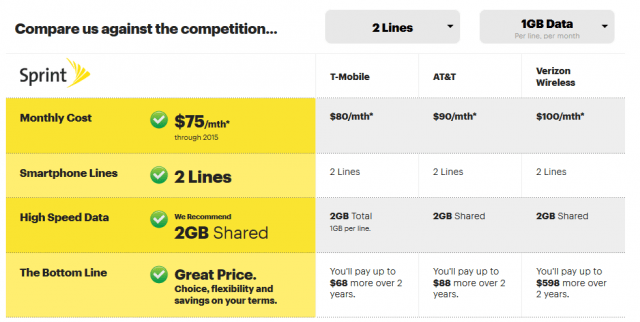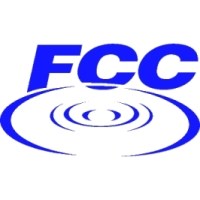 The Federal Communications Commission announced Friday it will postpone an important spectrum auction until 2016 after broadcasters filed suit against the regulator challenging its proposed format.
The Federal Communications Commission announced Friday it will postpone an important spectrum auction until 2016 after broadcasters filed suit against the regulator challenging its proposed format.
The FCC wants your free, over-the-air television dial to be a lot smaller with a deal that will pay broadcasters to sign-off their channels for good to benefit the wireless industry. Remaining stations will be moved to VHF channels 2-13 and UHF channels 14-30. The spectrum covering UHF channels 31-51 would likely then be sold in pieces to major wireless carriers including AT&T, Verizon Wireless, Sprint, and/or T-Mobile.
To entice broadcasters to voluntarily switch off their transmitters, the FCC has designed a spectrum auction that would provide tens of millions in proceeds to smaller stations and up to $570 million for a UHF station in Los Angeles to get off the air. Technically, stations giving up their channels don’t have to sign-off — they can move to low/lower-powered broadcasting, share channel space with another television station on a digital subchannel, or move to cable television exclusively.
To sell stations on the deal, FCC Chairman Tom Wheeler hired Greenhill, a Wall Street investment bank, to prepare a presentation sent to every eligible television station in the country, encouraging them to sell their channels for some eye-popping proceeds:
(These numbers refer to full-power stations; in some markets there are also Class A stations, low-power stations that meet certain programming requirements. The estimated value of their spectrum is lower.)
|
In millions of dollars |
| MARKET |
Full-Power Stations |
|
Maximum |
Median |
| New York |
$490 |
$410 |
| Los Angeles |
$570 |
$340 |
| Chicago |
$130 |
$120 |
| Philadelphia |
$400 |
$230 |
| Dallas-Fort Worth |
$67 |
$53 |
| San Francisco-Oakland-San Jose |
$140 |
$110 |
| Boston |
$140 |
$93 |
| Washington, D.C. |
$140 |
$130 |
| Atlanta |
$91 |
$65 |
| Houston |
$52 |
$45 |
| West Palm Beach |
$100 |
$93 |
| Providence, R.I. |
$160 |
$110 |
| Flint, Mich. |
$100 |
$45 |
| Burlington, Vt. |
$58 |
$17 |
| Youngstown, Ohio |
$95 |
$90 |
| Palm Springs, Calif. |
$180 |
$100 |
| Wilkes-Barre-Scranton |
$150 |
$140 |
Source: The FCC
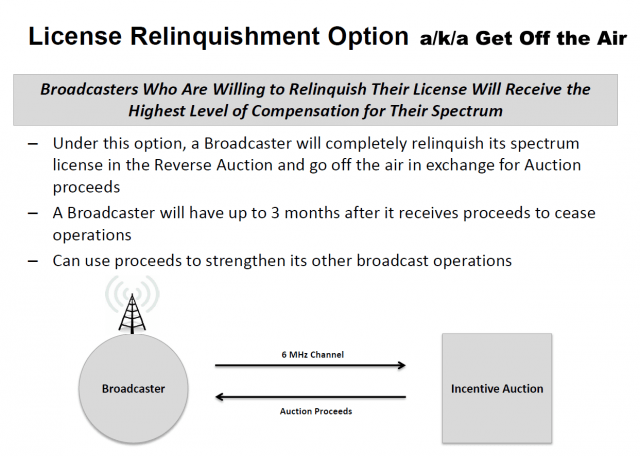 There is so much money to be made buying and selling the public airwaves — at least twice as much as broadcasters originally anticipated– spectrum speculators have also jumped on board, snapping up low power television station construction permits and existing stations with hopes of selling them off the air in return for millions in compensation. Wireless customers are effectively footing the bill for the auction as wireless companies bid for the additional spectrum. Television stations will receive 85% of the proceeds, the FCC will keep 15%.
There is so much money to be made buying and selling the public airwaves — at least twice as much as broadcasters originally anticipated– spectrum speculators have also jumped on board, snapping up low power television station construction permits and existing stations with hopes of selling them off the air in return for millions in compensation. Wireless customers are effectively footing the bill for the auction as wireless companies bid for the additional spectrum. Television stations will receive 85% of the proceeds, the FCC will keep 15%.
 Major network-affiliated or owned stations in major cities are unlikely to take the deal. But in medium and smaller-sized markets where conglomerates own and operate most television stations, there is a greater chance some will be closed down, moved to a lower channel, or transferred to a digital sub-channel of a co-owned-and-operated station in the same city. The most likely targets for shutdown will be independent, CW and MyNetworkTV affiliates. In smaller cities, multiple network affiliates owned by one company could be combined, relinquishing one or more channels in return for tens of millions in cash compensation.
Major network-affiliated or owned stations in major cities are unlikely to take the deal. But in medium and smaller-sized markets where conglomerates own and operate most television stations, there is a greater chance some will be closed down, moved to a lower channel, or transferred to a digital sub-channel of a co-owned-and-operated station in the same city. The most likely targets for shutdown will be independent, CW and MyNetworkTV affiliates. In smaller cities, multiple network affiliates owned by one company could be combined, relinquishing one or more channels in return for tens of millions in cash compensation.
In Los Angeles, the stakes are especially high with auction prices estimated at up to $570 million for a high-powered UHF station like KDOC-TV.
“There is some real money to be had,” Bert Ellis, chief executive of Ellis Communications, which owns KDOC-TV, told the Wall Street Journal. “I think every broadcaster should take a very close look at this.”
Estimates show at least 80 significant U.S. cities will likely lose one or more channels, especially when the bid price well exceeds the value of an independent, ethnic or religious station. Many of these will go dark, move to cable or a less desirable lower power VHF channel, or sign an agreement with a remaining station to carry its programming on a sub-channel.
The National Association of Broadcasters filed suit against the FCC’s auction in August. The NAB wants the FCC to guarantee that stations that wish to stay on the air will not have their coverage area reduced or forced to pay to move to a new channel number assigned by the FCC as the regulator “repacks” a much smaller UHF band.
“We’ve said from day one, if stations want to volunteer to go out of business, that’s their prerogative. But for those stations that choose to remain in business, they should be held harmless,” NAB spokesman Dennis Wharton said.
The spectrum auction is designed to address the wireless industry’s claim of a spectrum crisis, warning that if more frequencies are not found, wireless users will eventually see their service degraded.
 American Airlines left passengers stewing for more than three hours on board a flight from LAX to London before finally returning to the gate. The reason? A passenger reported a functioning Wi-Fi hotspot labeled “Al Quida Free Terror Nettwork” and complained to a flight attendant.
American Airlines left passengers stewing for more than three hours on board a flight from LAX to London before finally returning to the gate. The reason? A passenger reported a functioning Wi-Fi hotspot labeled “Al Quida Free Terror Nettwork” and complained to a flight attendant.

 Subscribe
Subscribe The Federal Communications Commission announced Friday it will
The Federal Communications Commission announced Friday it will  There is so much money to be made buying and selling the public airwaves — at least twice as much as broadcasters originally anticipated– spectrum speculators have also jumped on board, snapping up low power television station construction permits and existing stations with hopes of selling them off the air in return for millions in compensation. Wireless customers are effectively footing the bill for the auction as wireless companies bid for the additional spectrum. Television stations will receive 85% of the proceeds, the FCC will keep 15%.
There is so much money to be made buying and selling the public airwaves — at least twice as much as broadcasters originally anticipated– spectrum speculators have also jumped on board, snapping up low power television station construction permits and existing stations with hopes of selling them off the air in return for millions in compensation. Wireless customers are effectively footing the bill for the auction as wireless companies bid for the additional spectrum. Television stations will receive 85% of the proceeds, the FCC will keep 15%. Major network-affiliated or owned stations in major cities are unlikely to take the deal. But in medium and smaller-sized markets where conglomerates own and operate most television stations, there is a greater chance some will be closed down, moved to a lower channel, or transferred to a digital sub-channel of a co-owned-and-operated station in the same city. The most likely targets for shutdown will be independent, CW and MyNetworkTV affiliates. In smaller cities, multiple network affiliates owned by one company could be combined, relinquishing one or more channels in return for tens of millions in cash compensation.
Major network-affiliated or owned stations in major cities are unlikely to take the deal. But in medium and smaller-sized markets where conglomerates own and operate most television stations, there is a greater chance some will be closed down, moved to a lower channel, or transferred to a digital sub-channel of a co-owned-and-operated station in the same city. The most likely targets for shutdown will be independent, CW and MyNetworkTV affiliates. In smaller cities, multiple network affiliates owned by one company could be combined, relinquishing one or more channels in return for tens of millions in cash compensation. Rogers Communications will acquire Hamilton, Ont.-area independent Source Cable in a quiet $160-million deal.
Rogers Communications will acquire Hamilton, Ont.-area independent Source Cable in a quiet $160-million deal.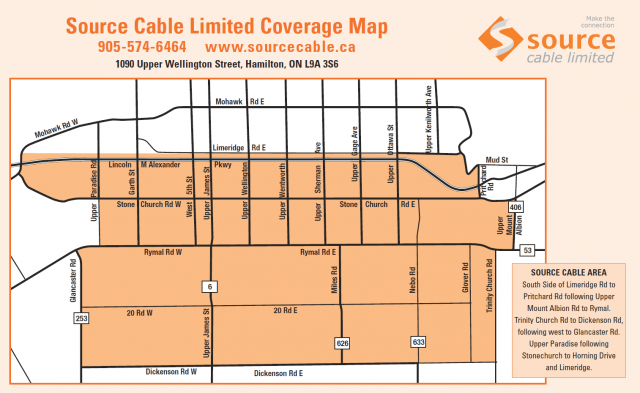
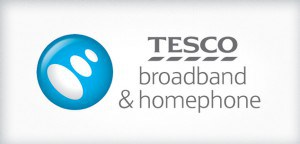 One of the largest grocery chains in the United Kingdom is giving away free unlimited 16Mbps broadband for a year, including a free wireless router, as long as customers cover the usual monthly line rental fees.
One of the largest grocery chains in the United Kingdom is giving away free unlimited 16Mbps broadband for a year, including a free wireless router, as long as customers cover the usual monthly line rental fees. If your family budget cannot handle a $200 monthly cell phone bill from AT&T or Verizon and you can keep your data usage to around 1GB, Sprint has a deal for you.
If your family budget cannot handle a $200 monthly cell phone bill from AT&T or Verizon and you can keep your data usage to around 1GB, Sprint has a deal for you.